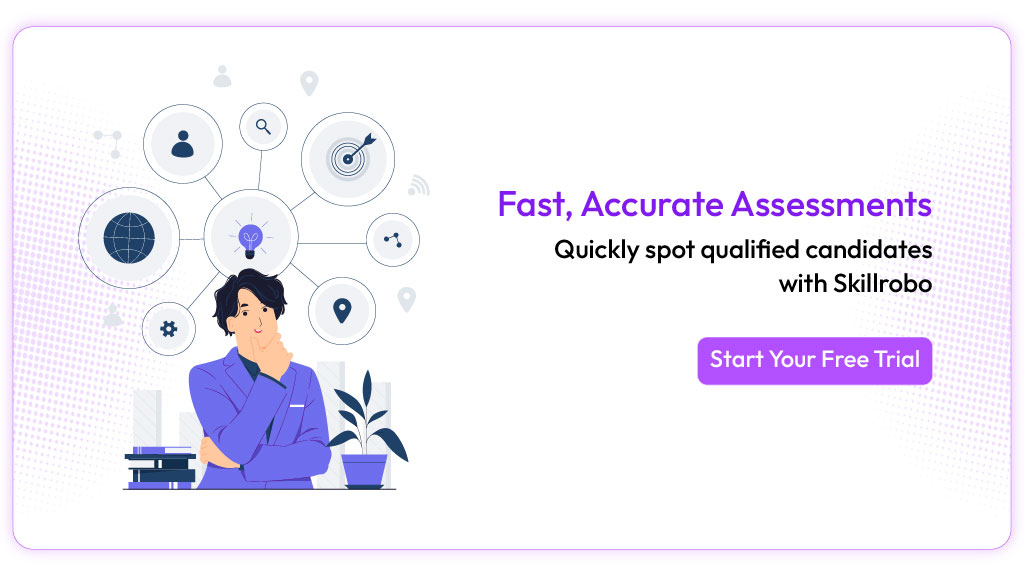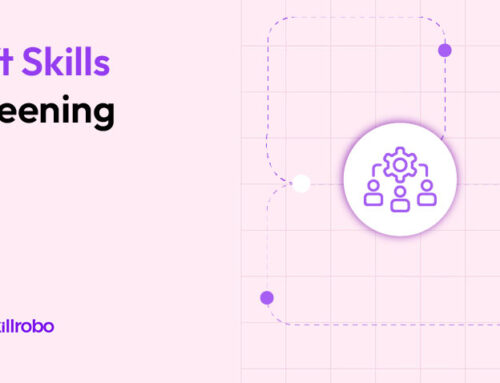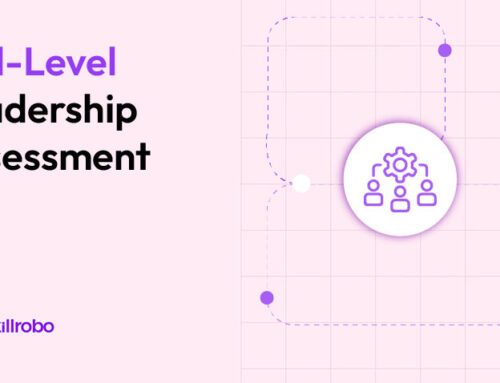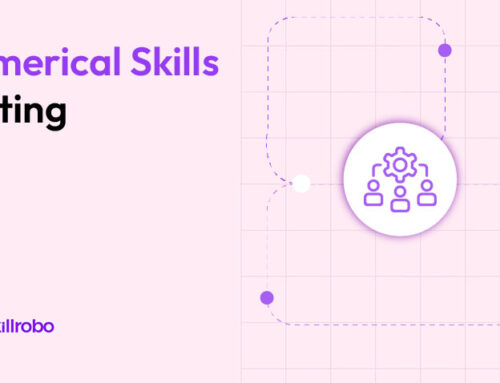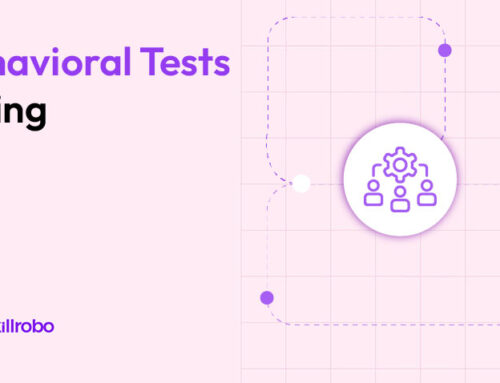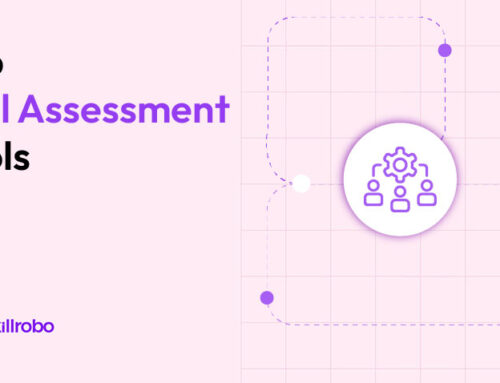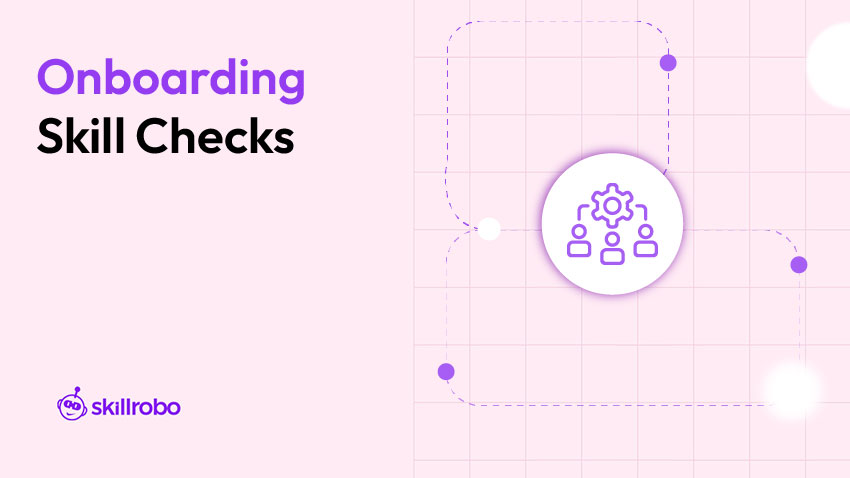
Key Takeaways
- Onboarding skill assessments provide clarity on new hire strengths and gaps, enabling tailored development from day one.
- Personalized onboarding improves retention and time-to-productivity by aligning training with role-specific needs.
- Combining assessments with onboarding tools ensures a data-driven transition into the performance-focused culture.
- Platforms like Skillrobo offer flexible assessment delivery and detailed insights that support customized onboarding strategies.
Beyond Welcome Emails and Office Tours
A successful onboarding process does more than introduce company culture; it empowers new hires to perform. Yet, most companies rely on generic orientations that overlook skill gaps. Integrating assessments into onboarding shifts the focus from paperwork to performance readiness.
This blog explores how to embed assessments into onboarding workflows to enhance training, improve retention, and align talent with business needs, starting from day one.
The Onboarding Gap: Why Most New Hires Aren’t Fully Ready
Many organizations assume that a signed offer means a job is understood. But even qualified candidates may have gaps in tools, techniques, or soft skills specific to your company.
Common onboarding pain points:
- Mismatched training paths due to a lack of role clarity
- Wasted L&D resources on irrelevant modules
- Frustration from unclear performance expectations
When skill assessments are built into onboarding, they act as diagnostic tools to tailor the learning journey for each new hire.
How Assessments Transform Onboarding from Generic to Personalized
Most onboarding programs follow a predictable script: company policies, team introductions, and a standard set of training modules. While this approach checks the boxes, it often fails to consider what each new hire truly needs to succeed in their specific role.
Skill assessments add the missing layer of insight.
By evaluating an employee’s strengths, gaps, and role-readiness from the very start, assessments help shift onboarding from a one-size-fits-all process to a tailored experience. This transformation not only improves knowledge retention but also accelerates ramp-up time, boosts engagement, and sets a foundation for long-term performance.
Here’s how assessments improve onboarding outcomes across the most critical areas of talent development:
1. Establishes a Performance Baseline Early
Testing role-specific knowledge during onboarding sets a clear baseline. For example, a logistics coordinator might complete a timed inventory simulation to benchmark accuracy. These insights allow managers to measure growth over the first 30–90 days.
2. Aligns Training with Actual Needs
Instead of assigning an entire course catalog, you can assign learning paths based on real gaps. If a new hire in finance scores low in Excel modeling, they’re routed to targeted training, saving time and increasing relevance.
3. Accelerates Time to Productivity
Focused learning leads to faster ramp-up. A customer support hire assessed on soft skills can receive communication coaching before handling real tickets, minimizing early missteps.
4. Improves Manager Coaching
With assessment data in hand, managers can personalize feedback and goals. It also enables transparent conversations early, setting expectations and boosting trust.
Interactive Onboarding Flow: From Assessment to Action
Traditional onboarding often relies on slide decks, checklists, and standardized training modules. But high-impact onboarding aligns skill development with role-specific goals, starting from the moment an employee joins. Here’s a smarter, more personalized onboarding flow where skill assessments drive every step of the journey.
Step 1: Welcome & Role Orientation
Goal: Set expectations, build rapport, and provide clarity on responsibilities.
Start with a brief introduction to the team, job function, tools they’ll use, and success metrics. This phase builds psychological safety and sets the stage for assessments that follow. Highlight core deliverables and introduce the idea that onboarding is personalized based on skill insights.
Consider offering a short, informal behavioral assessment here to understand how the employee prefers to work, communicate, and learn.
Step 2: Role-Specific Skill Assessment
Goal: Evaluate job-critical capabilities right at the start.
Deliver a targeted assessment tailored to the new hire’s function. For example, a data analyst might complete an Excel benchmarking test, while a support rep may handle a customer scenario simulation.
Use tools like online production skills assessment tests to evaluate how well employees can perform core tasks under realistic constraints. These results lay the groundwork for personalizing the rest of the onboarding experience.
Step 3: Personalized Feedback Report
Goal: Create transparency and identify training opportunities early.
Once the assessment is complete, share a categorized feedback report showing how the employee performed across different competencies. These insights should be constructive, not evaluative, and help the employee feel supported rather than judged.
Skillrobo’s reporting engine can break down strengths and gaps by category, allowing new hires to visualize where they stand. Tools like employee assessment software make this seamless and data-driven, ensuring clear visibility for both the employee and their manager.
Step 4: Learning Path Assignment
Goal: Direct new hires to the right training content based on real skill gaps.
Based on assessment performance, automatically enroll the employee in targeted training modules. For example, someone scoring low in data interpretation could be assigned a foundational analytics course, while someone excelling in communication might skip basic modules and move on to leadership-building tracks.
Using structured logic from tools like roles for Microsoft Office skills ensures that training paths are not only personalized but also relevant to job function and proficiency level.
Step 5: Manager Touchpoint & Goal Setting
Goal: Align expectations, offer coaching, and set performance goals.
At the end of the first week or after initial training, managers should meet with the new hire to review assessment data, discuss feedback, and set SMART goals. Use insights from the onboarding assessment to co-create a 30/60/90-day plan that supports growth and tracks tangible outcomes.
This step shifts the manager’s role from task assigner to growth coach, strengthening relationships and improving retention. Tie in alignment with performance tools like competency assessment tools to track long-term leadership and development potential from the outset.
Tip: Consider visualizing this journey with icons or a horizontal step-by-step infographic if you’re publishing this on a blog or landing page—it not only improves engagement but also reinforces the idea that onboarding can be structured, measurable, and deeply personalized.
Pro Tips for Seamless Integration
Integrating skill assessments into onboarding doesn’t have to feel like adding pressure. With the right approach, it can enhance the experience, empowering both the new hire and the hiring manager. Below are simple but powerful best practices to ensure onboarding assessments are seamless, supportive, and effective.
- Keep it light in Week 1: Ease new hires into the flow by avoiding heavy assessments early on. Instead, start with short-form or scenario-based tasks that reflect real job situations without overwhelming them. For example, a situational judgment test can offer valuable behavioral insight in a low-pressure format. This helps build confidence and psychological safety from the start.
- Combine with orientation: Instead of positioning assessments as formal evaluations, frame them as part of a “get to know your strengths” experience. When bundled with onboarding sessions or team introductions, assessments feel more like a tool for growth than a test to pass. This subtle shift in positioning encourages honest participation and better results.
- Use the data collaboratively: Once assessments are complete, don’t just file the results away—share them. Walk through the feedback with new hires, highlighting both strengths and improvement areas. Platforms that offer instant reporting and analytics make it easy to deliver categorized insights, which can then be used as a foundation for personalized coaching and goal setting.
- Loop in managers: Ensure that hiring managers are part of the conversation. Share assessment summaries with them so they can tailor early tasks, feedback, and expectations accordingly. This builds alignment from day one and fosters more effective relationships between leaders and their new team members.
Skillrobo: Empowering Personalized Onboarding at Scale
Skillrobo is built for forward-thinking HR teams that want more than generic onboarding. With its customizable assessments, real-time reporting, and secure test delivery, it helps employers align onboarding with actual role demands.
- Tailored test creation: Use pre-designed templates or build your own for soft skills, tech skills, or compliance.
- SEYARC AI support: Auto-generate questions when you need to test niche or evolving competencies.
- Easy access & management: Share via public URLs, integrate with your HRMS, and manage users with flexible admin controls.
- Deep analytics: Get categorized, visual performance insights to identify gaps and inform coaching from day one.
With Skillrobo, onboarding becomes a strategic, skill-driven experience that sets new hires up for long-term success.
Conclusion
Integrating skill assessments into onboarding isn’t just a smart move; it’s a strategic one. It turns the first days of employment into a discovery phase, where both the organization and the new hire gain clarity on strengths, gaps, and growth paths.
With the right tools, formats, and mindset, onboarding assessments can shorten ramp-up time, personalize development, and increase retention. Platforms like Skillrobo make it easy to design assessments that feel less like exams and more like opportunities to grow.
Want to onboard smarter, not harder? Click here to sign up and start creating assessment-driven onboarding experiences with Skillrobo.
Table of content
- Key Takeaways
- Beyond Welcome Emails and Office Tours
- The Onboarding Gap: Why Most New Hires Aren’t Fully Ready
- How Assessments Transform Onboarding from Generic to Personalized
- Interactive Onboarding Flow: From Assessment to Action
- Pro Tips for Seamless Integration
- Skillrobo: Empowering Personalized Onboarding at Scale
- Conclusion

